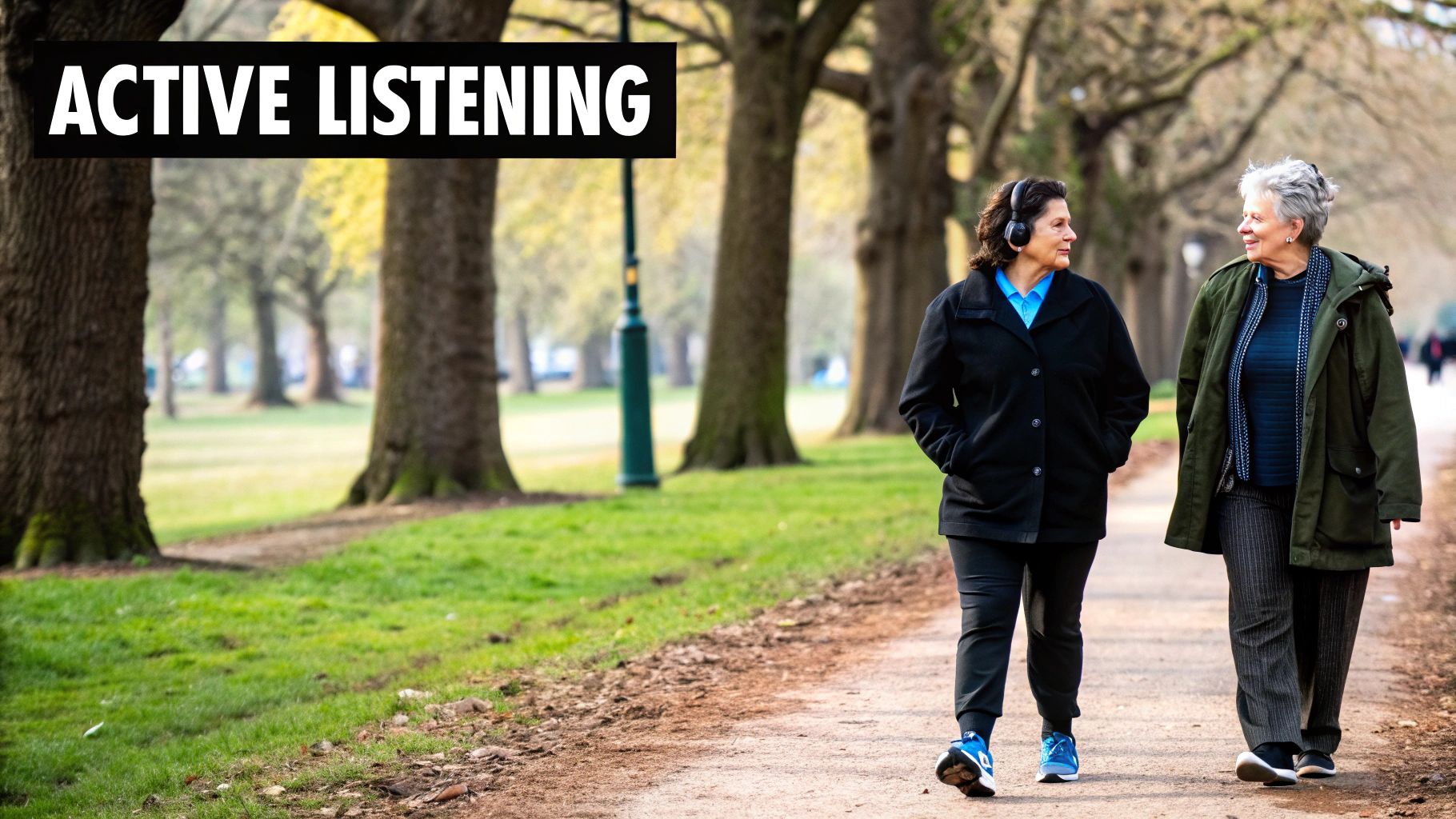The Science Behind Meaningful Intimacy

True intimacy blossoms from vulnerability, trust, and deep emotional connection. These interwoven elements create a safe haven for partners to authentically share themselves. Understanding the science behind these dynamics, particularly how our brains and bodies respond to connection, is key to building stronger, more satisfying relationships.
Attachment Styles and Intimacy
Our childhood experiences significantly mold our attachment styles, impacting how we approach intimacy as adults. Those with secure attachment styles often find intimacy easier, embracing vulnerability and closeness to forge deep connections.
However, individuals with insecure attachment styles, categorized as anxious or avoidant, may encounter challenges. Anxious individuals might crave intimacy yet fear rejection, leading to insecurity. Avoidant individuals might maintain emotional distance and struggle with vulnerability.
Recognizing your attachment style is crucial for understanding your intimacy patterns. This self-awareness helps address potential hurdles and cultivate more secure bonds.
The Role of Vulnerability
Vulnerability, the willingness to unveil our true selves, can feel risky. Yet, it’s the bedrock of genuine intimacy. Opening up to our partners creates space for profound connection and mutual understanding.
This can be daunting, especially for those with past hurts. Overcoming these intimacy barriers often involves forgiveness. This article offers guidance: How to Practice Forgiveness: Steps for Healing . This underscores the importance of emotional safety; vulnerability thrives in an environment of trust and acceptance.
Gender Differences and Intimacy
While broad generalizations about gender and intimacy can be misleading, research suggests some noteworthy trends. Studies indicate women often report experiencing greater intimacy in relationships than men. Building intimacy involves key elements, including attachment and closeness. One study found that women generally reported higher levels of intimacy than men, regardless of the relationship type or whether they had children (intimacy and attachment styles ).
This doesn’t imply men are incapable of intimacy; they may express it differently. These differences could arise from societal expectations or variations in emotional processing.
Acknowledging these nuances helps couples navigate their individual approaches to intimacy, fostering mutual understanding. Building intimacy requires ongoing effort, open communication, and a willingness to embrace vulnerability. It’s a continuous journey of growth and connection, enriching relationships.
Mastering Vulnerable Communication That Transforms

This infographic shows a couple enjoying time together. It highlights how important shared experiences are for building intimacy. The image emphasizes that intimacy grows not just through talking, but also through shared activities and connection. Creating these positive moments together builds a strong foundation for a deeper intimate connection.
Beyond Surface Conversations
Building true intimacy requires going deeper than everyday small talk. It means opening yourself up and communicating in a vulnerable way. This requires creating a safe environment where both partners feel comfortable sharing their true feelings and thoughts. For instance, instead of just describing your day, share how you felt about the things that happened.
This shift towards deeper sharing builds understanding and emotional connection. It allows you to see into your partner’s inner world and strengthens the bond between you.
Creating Emotional Safety
Emotional safety is crucial for vulnerability. It’s like building a bridge; you need a solid structure before you can cross. This environment of safety involves actively listening to your partner, empathizing with their feelings, and avoiding judgment. Validating your partner’s feelings, even if you don’t necessarily agree with them, is essential.
This builds trust and encourages further openness. It creates a foundation where both partners feel seen, heard, and accepted for who they are.
Expressing Needs Without Blame
Clearly expressing your needs is a vital part of healthy communication. However, phrasing your needs as accusations can make your partner defensive, which blocks intimacy. For example, instead of saying, “You never listen to me,” try, “I feel unheard when…”
This subtle change focuses on your personal experience instead of blaming your partner. It makes it easier for them to listen and respond constructively, allowing for a productive dialogue instead of an argument.
Navigating Communication Roadblocks
Even with the best intentions, roadblocks like criticism and stonewalling can appear. Criticism attacks the person, while stonewalling shuts down communication entirely. These behaviors create distance and damage intimacy.
It’s essential to recognize these patterns and replace them with healthier alternatives. Expressing concerns respectfully and taking breaks when feeling overwhelmed helps build stronger connections. This allows you to work through challenges without damaging the relationship.
The following table summarizes some communication techniques that can be used to foster intimacy:
Communication Techniques for Building Intimacy
A comparison of different communication approaches and their effectiveness in building emotional intimacy
| Communication Technique | Purpose | Implementation | Impact on Intimacy |
|---|---|---|---|
| Sharing emotional responses | To foster understanding and connection | Discuss feelings related to daily events | Increases empathy and closeness |
| Active listening and validation | To create emotional safety | Pay attention to your partner’s words and feelings; acknowledge their emotions | Builds trust and encourages openness |
| Expressing needs without blame | To promote healthy communication | Focus on “I” statements and express how you feel | Reduces defensiveness and fosters collaboration |
| Avoiding criticism and stonewalling | To prevent communication breakdowns | Replace negative communication patterns with respectful dialogue and breaks | Maintains connection and reduces conflict |
| Gradually increasing emotional disclosure | To build intimacy at a comfortable pace | Start with sharing less vulnerable information and gradually share more as trust grows | Strengthens the bond and deepens intimacy |
This table provides a roadmap for building more intimate relationships through healthy communication practices. By understanding the purpose and implementation of each technique, you can significantly improve your connection with your partner.
Increasing Emotional Disclosure
Gradually revealing more of your emotional self can feel like slowly wading into deeper water. Begin by sharing less sensitive information and gradually move towards deeper emotions as trust grows. This gives both partners time to adjust to the increasing level of intimacy.
Keep track of how comfortable you feel sharing and how your partner responds. This process creates positive reinforcement, confirming the safety and benefits of vulnerability.
The Touch Connection: Beyond Physical Affection

Physical touch is a basic human need, vital for building intimacy within a relationship. It’s a powerful form of communication that goes beyond words, creating a deep, neurological connection between partners. This connection nurtures feelings of security, trust, and belonging, all crucial for a strong and healthy relationship.
The Science of Touch and Intimacy
Touch triggers the release of oxytocin, a hormone often referred to as the “love hormone.” Oxytocin plays a key role in bonding and stress reduction. Different types of touch convey different messages. A gentle caress expresses tenderness, while a firm hug provides reassurance and support.
These non-verbal cues can significantly strengthen emotional bonds. For instance, holding hands during a stressful time offers comfort and a sense of shared experience. This reinforces the feeling of togetherness, building a foundation of support and resilience within the relationship.
Touch can also rekindle the spark in long-term relationships. It reminds partners of their deep connection amidst the everyday pressures of life.
Why Touch Matters in Relationships
Many couples, particularly those with busy schedules, inadvertently neglect physical affection. This can create distance and a sense of disconnection, even if love is still present. The importance of physical touch in fostering intimacy cannot be overstated.
A national survey by The Kinsey Institute and K-Y found that nearly 87% of people in committed relationships consider touch very or extremely important for intimacy. However, the survey also revealed a discrepancy between the desire for physical connection and the reality. Many couples aren’t experiencing as much touch as they’d like.
This disconnect can negatively impact relationship satisfaction and overall well-being. By prioritizing touch, couples can deepen their intimacy and strengthen their emotional connection. The survey highlights the need for open communication about touch. You can find the detailed survey results here .
Open communication helps bridge the gap between desired and actual physical affection. Partners can express their needs and preferences, ensuring both feel understood and respected. For helpful resources on improving communication, explore tips on how to improve your communication skills .
Overcoming Touch Aversion
Some people are naturally less comfortable with physical touch. This could be due to past experiences, personality, or sensory sensitivities. However, even those who are touch-averse can learn to appreciate and benefit from physical connection.
This process often involves gradual desensitization. It starts with less intimate touch, such as holding hands or short hugs. Then, as comfort levels grow, it progresses to more intimate forms of physical affection. This allows individuals to build trust and associate touch with positive feelings.
Respecting boundaries and communicating openly throughout this process is essential. This creates a safe and supportive environment for exploring physical intimacy at a pace that works for both partners.
Practical Approaches for Incorporating Touch
Building intimacy through touch doesn’t require grand gestures. Small, regular acts of physical affection can have a significant impact.
- Non-Sexual Touch: Holding hands, cuddling while watching a movie, or a light touch on the arm can communicate care and closeness.
- Massage: Offering a back rub can be a relaxing and intimate way to connect physically.
- Greeting and Farewell Rituals: A hug or kiss hello and goodbye establishes a sense of connection and continuity.
These simple actions, performed with intention and genuine affection, can significantly enhance intimacy and strengthen the bond between partners.
Creating Powerful Shared Experiences That Last
Meaningful shared experiences are essential for building intimacy. They create lasting memories and a stronger bond between partners, going beyond simple enjoyment. Let’s explore how these shared moments can transform a relationship.
Why Shared Experiences Matter
Shared activities trigger neurological responses that strengthen bonds in ways conversation alone can’t. When we engage in new and exciting activities with our partners, our brains release dopamine, the pleasure and reward neurotransmitter. This shared excitement improves how we perceive our partner, deepening our connection.
Learning a new skill together, like cooking a complex dish or taking a dance class, fosters a sense of shared accomplishment. Collaborating on such activities further strengthens the bond.
Novel experiences are especially impactful on relationship satisfaction. The thrill of discovering something new and the shared vulnerability of stepping outside our comfort zones together create lasting memories. This positive feedback loop enhances feelings of intimacy, making the relationship feel vibrant and alive.
Identifying Shared Activities
Finding the right shared activities requires more than just choosing something fun. It’s essential to select activities that align with both partners’ values and interests.
This could mean exploring shared hobbies, volunteering for a cause you both care about, or taking a weekend trip to a dream destination. The key is to find activities that create a shared sense of purpose and meaning.
Regular rituals can also strengthen your connection. This could be a weekly date night, a morning coffee routine, or a shared hobby like gardening. These rituals provide stability and predictability, fostering a sense of shared identity and belonging.
Balancing Comfort and Adventure
While comfortable, familiar activities are important for connection, incorporating new and challenging experiences is equally crucial. This balance prevents the relationship from becoming stagnant.
For new couples, trying new restaurants, exploring different hobbies, or taking a weekend trip to a new city can be exciting. Long-term partners should break free from routine. Learning a new language, taking a cooking class, or trying a new sport can rekindle the spark. The key is to step outside your comfort zones together, embracing the shared excitement of discovery.
Activities for Different Relationship Stages
Different relationship stages benefit from various types of shared experiences:
-
New Couples: Focus on activities that encourage discovery and self-disclosure. Try new restaurants, explore shared interests, or engage in conversations about personal values.
-
Established Couples: Deepen connection and maintain excitement. Consider weekend trips, pursuing shared hobbies, or creating regular rituals like date nights or game nights.
-
Long-Term Couples: Prioritize activities that break routine and rekindle passion. Try a new activity together, volunteer for a shared cause, or plan a romantic getaway.
To help illustrate this, let’s look at the following table:
Intimacy-Building Activities for Different Relationship Stages: A collection of activities organized by relationship stage and intimacy type they help develop.
| Relationship Stage | Activity Type | Specific Examples | Intimacy Benefit |
|---|---|---|---|
| New Couples | Discovery & Self-Disclosure | Trying new restaurants, exploring shared interests, discussing values | Builds understanding and connection |
| Established Couples | Deepening Connection | Weekend trips, shared hobbies, regular date nights | Strengthens existing bonds and maintains excitement |
| Long-Term Couples | Rekindling Passion | Trying a new activity together, volunteering, romantic getaways | Breaks routine and reignites intimacy |
This table highlights how different activities can cater to the evolving needs of a relationship, fostering intimacy at every stage.
By prioritizing shared experiences and incorporating them thoughtfully into your relationship, you can build lasting intimacy that strengthens your bond for years to come.
Sustaining Intimacy Through Life’s Transitions
Life’s transitions, such as career changes, having children, health issues, or simply aging, can significantly impact even the strongest relationships. These shifts often introduce new demands, responsibilities, and emotional complexities, which can challenge the very core of intimacy. Understanding how to navigate these changes is essential for maintaining a strong, connected bond.
Recognizing Shifting Needs
As we move through life, our individual needs, desires, and priorities naturally change. What once fostered intimacy may no longer resonate in the same way. Recognizing these evolving needs, both in yourself and your partner, is the first step in sustaining a deep connection. This involves open and honest communication, actively listening to your partner’s concerns, and expressing your own needs without placing blame.
For example, a new parent might prioritize sleep over late-night conversations, while a partner facing a career change might require additional emotional support. Being sensitive to these shifts allows for adjustments and prevents resentment from developing. This awareness allows couples to adapt their approaches to intimacy and ensures both partners feel understood and supported.
Adapting and Rekindling Intimacy
Adaptability is key to navigating transitions in a relationship. This might mean redefining date nights to accommodate busy schedules, finding new ways to show affection, or simply making time for meaningful conversations amidst the daily chaos. Just as our individual needs change, so too should our expressions of intimacy.
Perhaps physical touch becomes more crucial during stressful periods, or verbal affirmations become essential when self-esteem is low. Learning to express and receive love in ways that resonate with your partner’s current needs is paramount. After periods of distance, rekindling closeness requires intentional effort.
This could involve planning a weekend getaway, setting aside dedicated couple time, or engaging in small gestures of affection, like leaving a loving note or offering a comforting touch. These acts of reconnection demonstrate care and commitment, reaffirming the bond amidst life’s demands. Cultivating intimacy in long-term relationships involves rapport and understanding. Research shows that even in commercial settings, intimacy, while perceived differently, still involves a deep emotional connection. Learn more about intimacy in different contexts.
Addressing Unresolved Conflicts
Unresolved conflicts and resentments can act like a slow poison, gradually eroding the foundation of intimacy. Ignoring these issues only allows them to fester, creating distance and distrust between partners. Addressing these challenges directly, before they become serious threats to the relationship, is essential for maintaining a healthy connection.
This requires creating a safe environment for open and honest dialogue. Using “I” statements to express feelings without assigning blame, actively listening to your partner’s perspective, and seeking compromise are crucial for resolving conflict constructively. Sometimes, professional guidance can be invaluable. A therapist can provide tools and strategies for navigating difficult conversations and developing healthier communication patterns.
Maintaining Individual Growth Within the Partnership
Nurturing individual growth while simultaneously strengthening the partnership is a delicate balancing act. While shared experiences are vital for building intimacy, it’s equally important to maintain individual identities and pursue personal interests. This allows partners to bring fresh energy and new perspectives into the relationship, preventing stagnation.
Encouraging each other’s personal growth, celebrating individual achievements, and respecting each other’s need for personal space create a dynamic where both partners feel fulfilled and supported. This fosters a sense of independence within the interdependence of the relationship, resulting in a stronger, more resilient bond. This means actively supporting each other’s hobbies, career goals, and personal development journeys. This balance between togetherness and individuality creates a vibrant, fulfilling partnership built on mutual respect and a shared commitment to personal growth.
Healing Intimacy Barriers: From Wounds to Connection
Past experiences, particularly those involving emotional or physical trauma, can create significant barriers to intimacy. These past wounds can manifest as a fear of vulnerability, difficulty trusting others, and emotional distance. However, healing is possible. Building genuine intimacy can emerge from addressing these past hurts.
Identifying Intimacy Blocks
The first step towards healing is identifying your personal intimacy blocks. These blocks can stem from various sources, including childhood experiences, past relationships, or traumatic events. Reflecting on past experiences and identifying recurring patterns in your relationships can illuminate these hidden obstacles.
For example, if you consistently find yourself withdrawing emotionally when a relationship becomes more serious, this could indicate a fear of vulnerability rooted in past hurt.
Additionally, consider how your attachment style influences your relationships. Secure attachment fosters intimacy, while insecure attachment (whether anxious or avoidant) can hinder connection. Recognizing your attachment style empowers you to address potential challenges proactively.
Communicating Through Sensitive Issues
Communicating about sensitive issues without triggering defensive responses is crucial for healing intimacy barriers. This involves creating a safe space where both partners feel comfortable sharing their vulnerabilities. Active listening, empathy, and validating your partner’s feelings (even if you don’t agree with them) are essential.
For example, instead of criticizing your partner’s reaction to a sensitive topic, try saying, “I understand why you feel that way, and I want to hear more about your experience.” This fosters understanding and creates a more receptive environment for deeper communication.
Rebuilding Trust and Connection
Rebuilding trust requires consistent, positive interactions. Small acts of kindness, emotional support, and showing up for your partner in meaningful ways demonstrate commitment and create a sense of security. This can be as simple as actively listening when your partner is sharing their day or offering a comforting hug during a stressful time.
Furthermore, gradually increasing emotional disclosure strengthens the bond and allows for deeper levels of intimacy. Start with sharing less vulnerable information and move towards more sensitive topics as trust develops. This creates a positive feedback loop, reinforcing the safety and benefits of vulnerability.
Seeking Professional Support
Sometimes, healing intimacy barriers requires professional guidance. A therapist specializing in relationship issues or trauma can provide tools and strategies for navigating these challenges. They can also help facilitate communication and create a safe space for exploring sensitive topics. If past traumas significantly impact your ability to build intimacy, seeking professional support can be incredibly beneficial.
Recognizing when professional support is necessary is a sign of strength. Just as we seek medical help for physical ailments, seeking therapeutic support for emotional wounds is a healthy and proactive step towards healing. Don’t hesitate to reach out for help when needed.
Through these steps, healing from past wounds and building genuine intimacy is possible. Remember, building intimacy is a journey, not a destination, and it requires ongoing effort, patience, and compassion from both partners.
Ready to deepen your understanding of intimacy and pleasure? Explore G-Spot 101 today! Learn More
The post How to Build Intimacy: Proven Ways to Strengthen Your Relationship appeared first on G Spot 101 .
Intimate Tickles found this article quite interested, and we thought you might to. We give all the credit for this article to gspot. Click Here To Read This Article From It's Original Source



